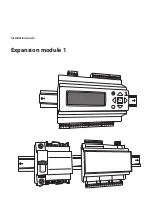
4.4 Pressure Relief Valve
The requirements recommended for the pressure relief valve are
as follows:
The pressure relief valve is calibrated to be activated at a
maximum pressure of 3 bar, and all the pipes and connections
must therefore be able to withstand pressures of up to 3 bar.
Connect the pressure relief valve drain to a tube with a
diameter of at least Ø15 mm. It must tilt in a downstream
direction throughout its entire length, and the water must run
off to a suitable drain. It must be positioned so as not to cause
damage to cabling, electrical equipment or persons.
The drain must not be located above a window, entry door or
any other public access point. Bear in mind that boiling water
or steam could come out when draining.
4.5 Filling the system
Before filling the boiler pipes, pull up the air flue cap to allow the
pipes to fill properly. Press the cap back in when the pipes are
full.
Air Flue Cap
Note
Ensure that the flue cap is fitted before testing or
operating the system.
Refer to the following illustration for system fill.
Stop
Valve
Cold mains Inlet
Temporary
Loop
Space hating Return
Stop
Valve
Double
Check
Valve
Note
The system must be filled with approved
equipment and comply with all regulations for
system fill.
To perform an air purge after initially filling the
boiler pipes, the pump will run for 5 minutes and
20 seconds. The boiler will operate normally after
performing an air purge.
4.6 Testing the Water System
WARNING
Ensure that the boiler is full of water before firing the burner.
Operating the unit without filling it will damage the boiler.
Such damage is not covered by the warranty, and may result
in property damage or severe personal injury.
Perform a fill test after installing the boiler’s water system to
make sure that the system has been installed properly. Follow
the instructions below to perform a fill test on the water system.
1. Close the manual air flues and the boiler drain valve.
2. Fill the boiler. The correct pressure will vary with each
application.
3. If the pressure is lower than the minimum pressure set (1 bar
by default), error code E02 will appear on the display.
4. Fill the boiler with more water until the error message
disappears.
5. At initial fill and during boiler start-up and testing, check
the system thoroughly for leaks. Repair any leaks before
proceeding further.
WARNING
Eliminate all system leaks. The continual introduction of fresh
makeup water will reduce boiler life. Minerals can build up in
the heat exchanger, reducing heat transfer, overheating the
heat exchanger and causing heat exchanger failure.
CAUTION
Before operating the boiler for the first time, ensure that the
boiler system is filled with water. Purge the air inside the
system to avoid damage to the boiler.
WARNING
If a gas type other than the one specified on the boiler
reference plate is used, it could cause a fire or even an
explosion.
It is important to ensure that the gas supply is suitable
for the type and capacity of the boiler.
Thoroughly check the seal and draining of the entire
installation, as a gas leak could cause serious damage.
DANGER
Gas leaks can cause explosions resulting in serious
personal and material damage.
Keep all doors and windows open while you are bleeding
the gas pipes and put out any cigarettes, flames or other
possible source of ignition.
For the installation of any type of gas, the installer must be
authorised by the Ministry of Industry and strictly follow the
applicable Gas Regulations. The gas installation must comply
with the Gas Installation Regulation.
However, the following recommendations must be complied
with, at the least:
Before installing the gas pipes, check the type of gas is
compatible with the boiler.
Check that the gas meter in the home can measure the rate of
gas supply required.
The gas pipe diameter is not determined by the boiler
connection. It should be calculated in accordance with its
length and consequently its pressure drop.
The pipes must be directly connected to the main gas supply
pipe, not connected in parallel to other gas appliances.
Check there are no leaks from the installation.
The gas supply company is solely responsible for connecting
the gas meter to the gas installation.
To connect the gas supply:
1. Connect the gas supply pope to the connection located on
the underside of the apliance.
2. After completing the gas installation, check there are no
leaks and bleed the air from all the pipes, following the
procedures described in the applicable standards to this
respect.
Gas Shutoff Valve
Gas Supply
Union
Bottom View
Gas Inlet Adapter
Union
5. Connecting the Gas Supply
24 Installing the System Piping
Summary of Contents for NCB-20LHWE
Page 41: ...41 Wiring Examples for Different Applications...
Page 71: ...71 13 4 Ladder Diagram 3 15A Appendices...
Page 75: ...Memo...
Page 76: ...Memo...
Page 77: ...Memo...
Page 78: ...Memo...
Page 79: ......
















































